BLOOD PASSOVER
(PASQUE DI SANGUE)By ARIEL TOAFF
CHAPTER THIRTEEN
p. 189]
TO DIE AND KILL FOR THE LOVE OF GOD
In the late 14th century or early 15th century, a woman from Esztergom, in northern Hungary, wrote to the authoritative rabbi Shalom of Wiener Neustadt with an urgent and pathetic inquiry. Some years previously, in her native country, on a Sabbath day, the local Christians had assaulted the Jews, threatening to baptize their children by force. Seized by despair, the poor woman, to prevent her children from forced conversion, seized a knife and piously killed them. She then fled, taking refuge in Poland. But she was now seized by remorse and was turning to the learned rabbi to find out how to expiate her guilt and earn God’s pardon. Shalom of Wiener Neustadt had no hesitations of his kind and promptly reassured the woman that, in this kind of tragic situation, the Jewish mother had acted for the better and in an appropriate manner, and was did not therefore deserve to be punished in any way [1].
Years before, in April 1265, when the Christians assaulted the Jewish district of Coblenz, in the Lower Rhineland, a Jew, fearing his family might be baptized by force, decided to kill his wife and four children, cutting their throats with a knife [2]. He then turned to Rabbi Meir da Rothenburg, one of the greatest authorities of Ashkenazi Judaism, asking if he should do penitence for that cruel action.
"Suicide for the sanctification of God is certainly permitted", replied the rabbi, "while, as regards the killing of other persons for the same reason, one must search for and find evidence in the texts. Any action of this type has been considered acceptable and even permissible for some time. We have personally learned and verified as true the fact that many illustrious Jews have killed their own children and wives (under similar conditions)" [3].
p. 190]
The fact that the mother from Esztergom and the father from Coblenz questioned the rabbi at all, asking what type of repentance was required, under Jewish law, for persons guilty of killing their own children to protect them from baptism, thus sacrificing them for the love of God, is a clear indication of a fear on their part that such actions might be quite incompatible with the dictates of the halakah, the ritual laws of Judaism. This fear, or if one prefers, this sense of uncertainty, must have been rather widespread among the Jewish populations of the German territories, as well as among their rabbis, as in the case of Meir da Rothenburg, since, rather than justify such behavior on the basis of Jewish law, they preferred to recall illustrious precedents, which had, in effect, rendered these actions permissible by adoption. The call to suicide and mass child murder, as well as to examples of collective martyrdom, such as that of Coblenz in 1096, was indirect, but nevertheless obvious.
In fact, the phenomenon of martyrdom among German Jews at the time of the First Crusade had no significant precedents in Judaism capable of explaining and justifying the phenomenon. Jewish chronicles written subsequent to those events, intended to describe the behavior of the Jews of the communities of the Valley of the Rhine in these situations, offered no excuse at all, nor did they appear to feel the need for justification of any kind. Under such tragic and exceptional circumstances, the choice to act contrary to the innate instinct to survive, and to love and care for one's children, was irrational, spontaneous and unpremeditated. The rational dictates of Jewish law could have no influence in such a situation [4].
German Jews were terrorized by the possibility of forceful conversion to Christianity. They were even more frightened of the possibility, which became a tragic reality in many cases, of seeing their own children violently dragged to the baptismal font. With obsessive insistence, the German Jewish communities, until the end of the beginning of the Crusades, addressed repeated and often useless appeals to their rulers so that their children might be protected from forced baptism [5]. Supplications to this effect are said to have been repeated over the following centuries, wherever there were Jewish nuclei of German origin, even in the regions of Northern Italy, becoming one of the distinctive features of Ashkenazi conduct [6].
To the teachers who killed their pupils, the mothers who cut the throats of their children, the fathers who killed their wives and children, conversion to Christianity represented a repellent and abhorrent eventuality. From their earliest childhood, the Jews
p. 191]
of the Franco-German territories had been taught to view the Christian faith as a despicable religion, barbarous and idolatrous, dedicated to the worship of images and holy cadavers. Baptism and the forced conversion of the Chosen People to the religion of their cruel and ignorant persecutors was surely the quickest passport to a base and corrupt life, deserving the severest divine punishment in both this world and the next. Death, death without hesitation of any kind, was to be considered a beneficial and desirable alternative [7].
In view of the intolerable menace hanging over the souls of the tender infants, born to be brought up in the love of the True God and according to His sacred dictates, yet fated to be immersed against their will in the contagious waters of baptism, the lethal blade was the sole adequate response. The blood shed by these innocent children, put to death for the love of God, was said to have served to bring forward the time of redemption. Their sacrifice, like that of the uncontaminated lambs offered as a holocaust on the altar of the Temple, was thought to help arouse Divine vengeance against their idolatrous persecutors. This vengeance was to be consummated from on High, in the Heavens, but needed to be prepared on Earth. God’s vengeance, and that of the fathers and mothers, compelled to shed the precious blood of their children by the extreme arrogance of the Christians [8].
Sometimes the synagogue was destined to be chosen as the favorite location for the sacrifice of these children and the sanctification of God’s name. The place of prayer conferred solemnity and rituality upon the drama being performed. The Holy Ark with the rolls of the Law (Aron ha-kodesh ), the pulpit, also called the almemor (or himah or tehah in Hebrew) [9], the benches upon which the faithful were accustomed to sit, were all bathed in the blood of the uncontaminated victims, while laments combined with invocations, litanies and imprecations, opening the way to Heaven. The sacred nature of the Temple failed to slow the arm of those who rose up to immolate, nor did the act reek of sacrilege. Quite the contrary, these surroundings constituted the most appropriate theatre for this act of sublime martyrdom. The story of Isacco, son of David, sacristan (parnas) of the synagogue at Magonza, who committed suicide during the first Crusade killing his children and mother and setting fire to the place of prayer, seems illuminating in this regard [10].
In those days, the great majority of the Jewish population of Magonza, after uselessly seeking refuge in the bishop’s palace, met death in an indiscriminate massacre. Few of their lives were spared. Among them, Isacco, the
p. 192]
sacristan of the synagogue, had personally been compelled to accept conversion to Christianity. But after a few days, the poor convert, assailed by remorse and repentance, dreamed up a delirious ritual of expiation based on a series of human sacrifices intended to move the Eternal to vengeance in a bath of blood.
First of all, Isaac, seized by fervent hallucinations, put his mother to death, burning her alive in her house. He then dragged his children, "not yet of an age capable of discerning good from evil" into the synagogue. Here, on the pulpit, the almemor, before the Ark containing the rolls of the Law, with his own hands, he slaughtered them all, one by one, offering a sacrifice to God. "And as the blood of the unhappy children spurted from their mortal wounds, painting the door-posts of the Ark of the Law, the sacristan devoutly recited: "May this blood serve as an expiration for all my sins". Immediately afterwards, he set fire to the synagogue, running from one side of the hall to another, his hands raised to Heaven in an act of prayer, his chanting voice clearly audible outside the holy sanctuary. And among the flames, before the holy Ark, the miserable Isacco finally found the death he so desired [11].
A psychopath? A lunatic suffering from homicidal religious fits of insanity? A poor soul driven mad by desperation and seized by a self-destructive mania? A madman and masochistic fanatic? The anonymous author who reports this tragic tale has absolutely no doubt at all of this kind: Isacco was a "wholesome and upright person, pious, merciful, and God-fearing". His behavior deserved to be pointed out as an example to later generations, and all types of censure in this case were to be considered absolutely unjustified and inopportune. Isacco had decided to sacrifice his own children on the almemor, before the Ark of the Law, the holiest place in the synagogue, according to a ritual, recalling, on the one hand, the holocaust offered on the altar of the Temple of Jerusalem, and, on the other hand, the Biblical sacrifice of Isaac, which, according to the Midrash, had actually been carried out. The grisly example of the pious sacristan of Magonza appeared to inspire enthusiastic and zealous imitators. The synagogue was thus transformed, in time, itself into a sort of sacred slaughterhouse, in which, among moans and prayers, the blood of the women and children, sacrificed for the love of God, gushed forth in torrents: Holy Ark, pulpit, women’s gallery, benches and steps were all stained red, as was the altar of the Temple.
[unnumbered illustration pages]
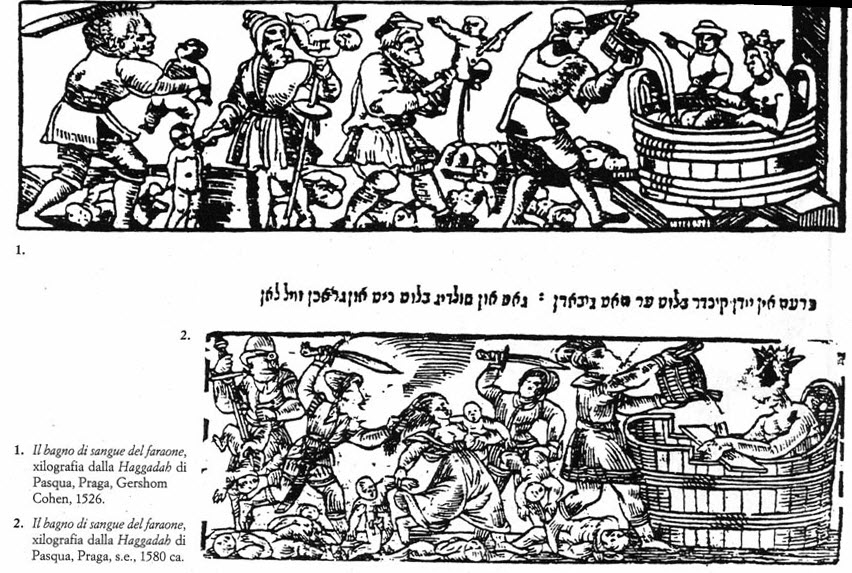
1. The Pharaoh's Bath of Blood, woodcut from the Haggadah of Passover, Prague, Gershom Cohen, 1526
2. The Pharaoh's Bath of Blood, woodcut of the Haggadah of Passover, same publisher, circa 1580
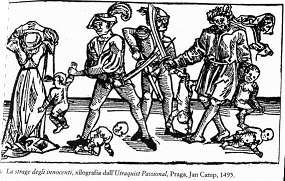
3. The Massacre of the Innocents, woodcut from the Ultraquist Passional, Prague, Jan Camp, 1495
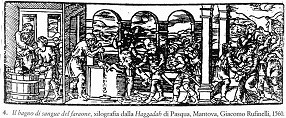
4. The Pharaoh's Bath of Blood, woodcut from the Haggadah of Passover, Mantua, Giacomo Rufinelli, 1560
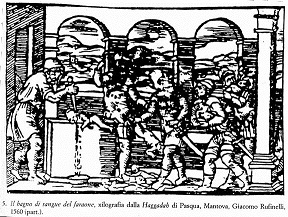
5. The Pharaoh's Bath of Blood, woodcut from the Haggadah of Passover, Mantua, Giacomo Rufinelli, 1560 (detail)
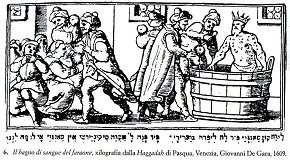
6. The Pharaoh's Bath of Blood, woodcut from the Haggadah of Passover, Venice, Giovanni De Gara, 1609
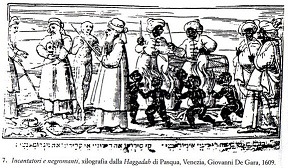
7. Enchanters and Necromancers, woodcut from the Haggadah of Passover, Venice, Giovanni De Gara, 1609
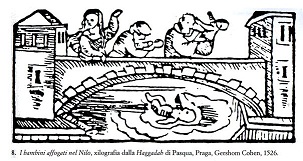
8. Children Drowned in the Nile, woodcut from the Haggadah of Passover, Prague, Gershom Cohen, 1526

9. Children Drowned in the Nile, woodcut from the Haggadah of Passover, Mantua, Giacomo Rufinelli, 1560
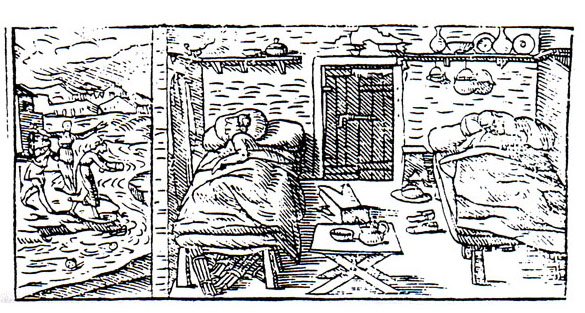
10. Children Drowned in the Nile, woodcut from the Haggadah of Passover, Venice, Giovanni De Gara, 1609
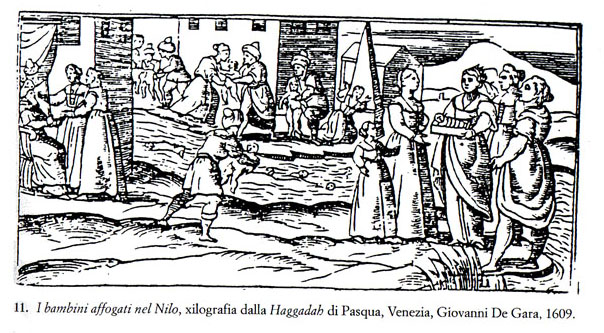
11. Children Drowned in the Nile, woodcut from the Haggadah of Passover, Venice, Giovanni De Gara, 1609
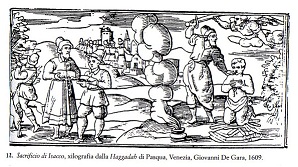
12. Sacrifice of Isaac, woodcut from the Haggadah of Passover, Venice, Giovanni De Gara, 1609
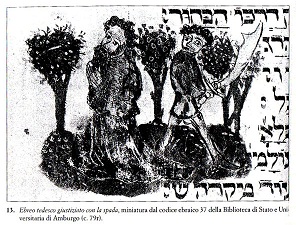
13. German Jew Being Executed with a Sword, miniature from Jewish Code 37 from the Hamburg State and University Library (c. 79r)
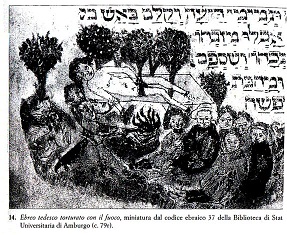
14. German Jew Tortured with Fire, miniature from Jewish Code 37 from the Hamburg State and University Library (c. 79r)
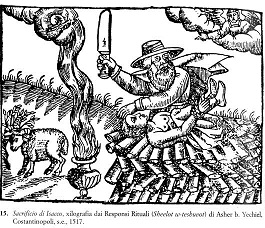
15. Sacrifice of Isaac, woodcut from the Ritual Responsals (Sheelot w-teshuvot) of Asher b. Yechiel, Constantinople, same publisher, 1517
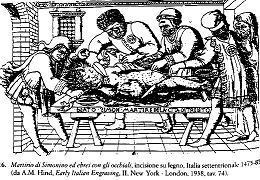
16. Martyrdom of Simonino and Jews with Eyeglasses, woodcut, Northern Italy 1475-85 (from A.M. Hind, Early Italian Engraving, II, New York-London, 1938, table 74
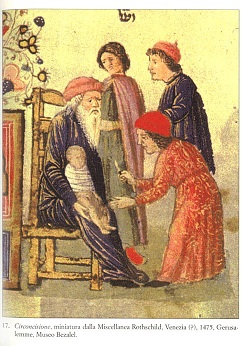
17. Circumcision, miniature from the Rotschild Miscellanea, Venice (?), 1475, Jerusalem, Bazelel Museum.
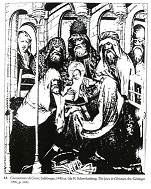
18. Circumcision of Christ, Salzburg, circa 1440 (from H. Schreckenberg, The Jews in Christian Art, Göttingen, 1996, p. 144).
19. Circumcision of Christ, altar piece, circa 1450, Nuremberg, Liebfraukirche.
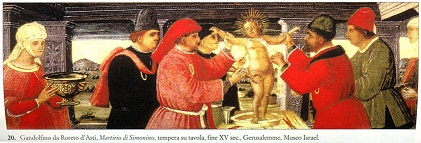
20. Gandolfino da Roreto d'Asti, Martyrdom of Simonino, tempera on wood, end of 15th century, Jerusalem, Israel Museum
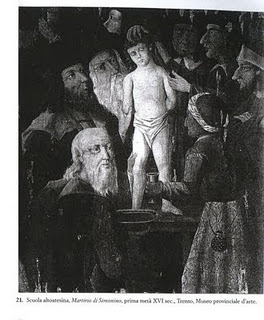
21. Altoatesina School, Martyrdom of Simonino, first half of 16th century, Trent, Provincial Museum of Art
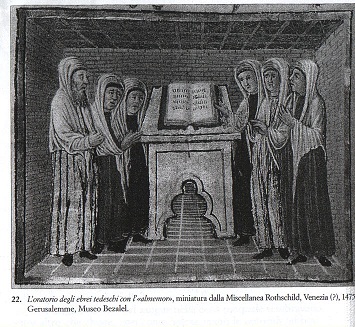
22. Oratory of German Jews with the "almemor", miniature from the Rothschild Miscellanea, Venice (?), 1475, Jerusalem, Bezalel Museum.
p. 193]
At Vienna in 1421, during that city’s violent riots against the Jews, accused of favoring and supporting the Hussites, the rabbi Natan Eger visited all the local Jewish boys in their own homes, and instructed their mothers to slaughter them without remorse if the Christians attempted to baptize them en masse. One Yiddish chronicle reports that, on that occasion, the Jewish community gathered a great number of children together in the synagogue to prevent their forced conversion, as vehemently demanded by an apostate.
"The Jews of the community at this point began to cry in a loud voice: 'Alas, (the Christians), may God forbid, intend to contaminate our children, holy and immaculate’. They therefore deliberated to deprive them of their lives in order to sanctify the name of God the Blessed.
They drew lots and selected the pious rabbi Jonah Ha-Cohen, who was responsible for putting the decision into action. This happened during the Festival of the Capanne (Sukkot).
"While the entire community murmured the formula of the call to repentance in a low voice, turning from one to another, the rabbi placed himself in front of the Ark containing the rolls of the Law, and cut the throats of all the children, one after the other. This occurred in the great hall, intended for men’s prayers. The women were also slaughtered, one by one, in the antechamber of the synagogue, intended for them, and this to sanctify the name of God. The last women waiting to be sacrificed turned to Jonah, the rabbi, asking him to butcher her (without entering the women's hall, but) causing his arm to pass through the grid, which separated the two halls. Then Johan the rabbi, having no more strength to kill himself, removed the rafters in the synagogue, made a stack of them, and poured oil on them, asking God to pardon him for that which he had done to save their souls. Finally, he curled up on the almemor, setting fire to them from on top, and met death in the midst of the flames" [12].
The blood of the sacrifice, far from contaminating the place, was to serve as an irresistible call to God, exhorting Him to implacable vengeance against His enemies and those of the Chosen People, as the necessary preamble to the much-desired Messianic redemption. The blood of the innocent children, shed in the synagogue "in sanctification of the name of God", or "as a sign of contempt and abomination of the heretical crucifix", therefore served the same function, or, more exactly, served as two symbolic and successive phases of the very same process towards final redemption.
The depositions of the defendants in the Trent trial were all in agreement as to the fact that the murder of little Simon was said to have been committed on Friday, inside the synagogue, located in the dwelling of Samuele da Nuremberg, and, more exactly, in the antechamber of the hall in which the men gathered in prayer. This area, which was separate
p. 194]
from the synagogue, properly speaking, by a door, was intended for women’s prayers, since there was no women’s gallery. The door, however, remained half-ajar; during the Sabbath liturgy, the women peeped in while the rolls of the Law were raised and exhibited by the person officiating at the almemor, before the reading of the weekly fragment of the Penteuch. On that occasion, the women placed their fingers to their lips and blew kisses in the direction of the rolls, open and placed on show. There, as the physician Tobias da Magdeburg informed the judges, "according to their customs the women gather in the antechamber of the synagogue and come forward at the door, when the (rolls with) the precepts of Moses were raised, which happens every Sabbath based on their rites" [13].
Simon’s crucifixion was alleged to have been committed on a bench located in the so-called "women's synagogue". The boy’s body, now lifeless, was then alleged to have been removed to the central hall of the synagogue and placed on the almemor for the ceremonies of the Sabbath. Tobias confirmed that, during the Sabbath liturgy, "he had seen the boy’s body stretched out on the almemor, which is a table in the middle of the synagogue, on which they place books" [14]. Angelo da Verona stated that "almemor is a Hebrew term equivalent in Latin 'seat of prayer'; in fact, the almemor is the table upon which they place the five books of Moses and is located in the midst of the School. The child’s body lay supine on the alememor (during the offices of the Sabbath)" [15].
The body was wrapped in a mappah (wimple) of variegated silk and embroidery, a fine cloth the size of a hand towel used to cover the rolls of the Law after the reading [16].
Israel Wolfgang testified before the Inquisitors of Trent in relation to the ritual child murder of Regensburg of 1467, at which he had personally participated, according to his own statement. In this case as well, the monumental ritual was alleged to have been committed in the antechamber of the synagogue; later, the body of the victim was said to have been transferred into the prayer room and placed in the almemor, so that the faithful might in some way participate in the significant ceremony [17].
Probably in an attempt to detract from the overly obvious anti-Christian connotations of the ritual of the child’s crucifixion, Angelo da Verona transformed it into an emblematic commemoration of the epic tale of the exodus from Egypt, explicitly linking it to the celebration of the Pesach. The wound inflicted on the victim’s jaw was said to have been required to recall Moses’ useless appeals to the Pharaoh
p. 195]
to free the people of Israel from the land in which they were being held prisoner. The wound on the tibia was said to have been a symbolic reference to the Egyptian army’s pursuit of the Jews in flight towards the Red Sea, and the terror and desperation with which the Jews were allegedly inflicted in those days. The amputation of the foreskin was said to have possessed an even more obvious commemorative function, recalling the mass circumcision of the Jewish people for the first time when they were about to leave Egypt, at God’s command [18]. The punctures in the victim’s body were said to have been inflicted to be taken as a symbol of the physical punctures inflicted by God upon the Egyptians, cruelly punished and suffering from a variety plagues [19].
Nevertheless, Angelo da Verona’s elaborate explanations, obviously intended to link the rite to the Biblical events celebrated in the Jewish Passover, hardly appear convincing. The defendants’ depositions actually provide obvious indications of the obvious intention to transform the child’s crucifixion into a symbolic commemoration of the Passion of Christ, referred to contemptuously as Tolle Iesse mina (= Talui, Ieshu ha-min), i.e., "the hanged one, Jesus the heretic" [20].
In effect, the so-called "Jewish formulae", which were said to have been pronounced on that occasion, cannot be dismissed as the mere expression of a mysterious, imaginary language, intended to confer Satanic connotations upon the cruel tale of ritual murder to satisfy the wishes of the inquisitors [21]. With some effort, due to the crude transliteration by Italian notaries of long and complicated phrases spoken in Ashkenazi Hebrew with a thick German accent, the formulae can be reconstructed rather satisfactorily, revealing their markedly anti- Christian tenor.
For example, the phrase in Hebrew recorded by Samuele of Nuremberg (lu herpo, lu colan, lu tolle Yesse cho gihein col son heno) and translated by Samuele as: "In contempt and shame of the hanged Jesus, and thus may it happen to all our enemies", is only apparently incomprehensible, due to inevitable errors of transcription by the notary. The phrase should in fact be reconstructed as "le-cherpah, li-klimah la-talui Yeshu, cach (or coh) ihye' le-col soneenu, in the German pronunciation (and therefore herpoh instead of herpah), precisely the same significance as attributed to it by Samuele, who had a good knowledge of Hebrew [22].
Mosè da Würzburg "the Old Man", reported that the rite, some of those present recited a Hebrew formula which meant: "Thou shalt be martyred as Jesus, the hanged God of the Christians, was martyred:
p. 196]
and thus may it happen to all our enemies". At this point, all persons present responded in unison: "Amen". The actual phrase, in mangled Hebrew, is as follows: "Hato nisi assarto fenidecarto cho Iesse attoloy le fuoscho folislimo cho Iesso" [23]. In view of the fact that the Hebrew was rendered according to the Ashkenazi pronunciation, the invective should be reconstructed as follows, leaving little room for doubt:
Attà nizlvatà we-nikartà ke-Ieshu ha-talui le-boshet we-li-klimà " (35th Psalm, 26), ke-Ieshu, which, literally translated, would sound like:
"You have been crucified and pierced like ‘Jesus the Hanged’, in ignominy and shame, like Jesus" [24].
For the participants in the ritual, the Christian child seems to have lost his identity (if he ever had any in their eyes) and had actually been transformed into Jesus the "crucified and hanged". So many Jewish boys baptized by force in Christ’s name in the German territories, beginning with the Crusades; so many others slaughtered by their fathers and mothers to avoid that holy abuse of power, bathing the almemor and the steps of the Ark with the rolls of the Law in the synagogue with their innocent blood -- now, in turn, those who considered themselves the descendents of the victims of forced baptism imagined that a cruel but holy representation of the memorial of the Passion was capable of redeeming the descendants from their unforgettable trauma, with the God of redemption, severe and pious, capable of vengeance and pardon, involved and satisfied, as a privileged witness.
NOTES TO CHAPTER THIRTEEN
[1] Shalom of Neustadt, Decisions and Customs, by Sh. Spitzer, Jerusalem, 1977, p. 137 (in Hebrew).
[2] Cfr. S. Salfeld, Das Martyrologium des Nuremberg Memorbuches, Berlin, 1898, p. 15.
[3] Meir of Rothenburg, Responsa, Decisions and Customs, by Y.Z. Kahana, Jerusalem, 1960, p. 54 (in Hebrew).
[4] In this regard, see the acute observations contained in H. Soloveitchik, Halakhah, Hermeneutics and Martyrdom in Medieval Ashkenaz, in "The Jewish Quarterly Review", XCIV (2004), pp. 77-105 ("the correctness of their conduct was axiomatic to them [...] and it was no less axiomatic to their successors [...]. Convinced of the palpable reality of the afterlife, feeling its almost graspable closeness [...] husbands killed wives and parents dispatched their children with a swift stroke of the knife, certain that they were bestowing upon them gift of eternal bliss")
[5] Cfr. B.Z. Kedar, The Forcible Baptism of 1096. History and Historiography, in K. Borchardt and E. Bünz, Forschungen zur Reichs-Papst- und Landesgeschichte. Peter Herde zum 65. Geburtstag, Stuttgart, 1998, pp. 187-200.
[6] In this regard, see A. Toaff, Migrazioni di ebrei tedeschi attraverso i territori triestini e friulani fra XIV e XV secolo, in G. Todeschini and P.C. loly Zorattini, Il mondo ebraico. Gli ebrei tra Italia nord- orientale e Impero asburgico dal Medioevo all'Età contemporanea, Pordenone, 1991, pp. 10-11; A. Toaff, Gli insediamenti ashkenaziti nell'Italia settentrionale, in Storia d'Italia. Annali. XI: Gli ebrei in Italia, t. I: Dall'Alto Medioevo all'età dei ghetti, by C. Vivanti, Torino, 1996, pp. 160-161.
[7] Cfr. Soloveitchik, Halakhah, Hermeneutics and Martyrdom in Medieval Ashkenaz, cit., pp. 105-106 ("Every aspect of the Christian religion was subject to ridicule and disgust. Much of the intuitive rejection of conversion in Ashkenazi communities come from the revulsion of Christianity instilled from childhood [...] their suffering filled them with bitterness [...]. Having one's children brought up as Christians meant not only having them raised as savages, worshipping idols and venerating corpses, but also becoming the blood-stained persecutors of the Chosen People; and after a barbaric and sin-filled life, they would be condemned to an eternity of death; a swift stroke of the sword was perhaps seen as the greatest kindness that a parent could bestow upon a child").
[8] In this regard, see, among others, I.J. Yuval, Vengeance and Damnation, Blood and Defamation. From Jewish Martyrdom to Blood Libel Accusations, in "Zion", LVIII (1993), pp. 33-90 (in Hebrew); Id., "The Lord Will Take Vengeance, Vengeance for His TempIe". Historia Sine Ira et Studio, in "Zion", LIX (1994), pp. 351-414 (in Hebrew). For a contrary opinion, see E. Fleischer, Christian-Jewish Relations in the Middle Ages Distorted, in "Zion", LIX (1994), pp. 267-316 (in Hebrew). See also M. Minty, Kiddush Ha-Shem in German Christian Eyes in the Middle Ages, in "Zion", LIX (1994), pp. 266-269 (in Hebrew).
[9] From the 13th century onwards, the tribune of the synagogue, (bimah, tevah), seat of the person officiating, was also referred to as the almemor, a term derived from the Arabic, al-minbar, "pulpit", exemplifying the forms and functions of the pulpit. The tribune contained the table (dukhan) bearing the roles of the Law during the weekly liturgical readings. It is curious to note the manner in which the term almemor, of Arabic origin, was also adopted by the Ashkenazi synagogues (cfr. Th. Metzger e M. Metzger, Jewish Life in the Middle Ages. Illuminated Hebrew Manuscripts of the XIIlth to the XVIth Centuries, Freiburg, 1982, pp. 71-74).
[10] The chronicle containing the tale of the tragedy of Isaac, the parnas [= president] of the synagogue at Magonza, is reproduced by A.M. Haberman, Sefer ghezerot Ashkenaz we-Zarf at ("Book of the Persecutions in Germany and France"), Jerusalem, 1971, pp.36-38.
[11] For a detailed examination of the affair with historical and ideological references, see J. Cohen, The Persecutions 0f 1096. From Martyrdom to Martyrology. The Sociocultural Context of the Hebrew Crusade Chronicles, in "Zion", LIX (1994), pp. 185-195 (in Hebrew); for an opinion closer to my own, see I.J. Yuval, "Two Nations in Your Womb". Perceptions of Jews and Christians, Tel Aviv, 2000, pp. 159- 161 (in Hebrew).
[12] Cfr. S. Bernfeld, Sefer ha-dema'ot ("The Book of Tears"), Berlin, 1924, p. 169. In this regard, see Yuval, "Two Nations in Your Womb", cit., pp. 199-200 and, more recently, A. Gross, Struggling with Tradition. Reservation about Active Martyrdom in the Middle Ages, Leyden, 2004, pp. 1-44.
[13] "lnterrogatus ubi erant mulieres ipsorum ludeorum, respondit quod non erant in sinagoga, quia non est de more eorum quod mulieres intrant sinagogam. Interrogatus ubi stant mulieres quando celebrantur offitia sua, respondit quod mulieres tunc stant in camera que est ante sinagogam. Interrogatus an mulieres stantes in dicta camera possint videre in sinagogam et maxime ea que sunt super almemore, respondit quod non, nisi veniant super ostium per quod intratur in sinagogam. Et dicit, interrogatus, quod secundum eorum consuetudinem mulieres, que se reperiunt in camera que est ante sinagogam, se reducunt super ostium quando elevantur precepta Moisi in sinagoga. Et dicit, interrogatus, quod dieta die Sabbati de sero precepta deberunt elevati, quia omni die Sabbato de sero elevantur, secundum eorum ordines" (cfr. A. Esposito e D. Quaglioni, Processi contro gli ebrei di Trento, 1475-1478. I: I processi del 1475, Padova, 1990, pp. 324- 325).
[14] "Vidit cadaver dicti pueri extensum super almemore, qui est discus positus in medio sinagoge, super quo ponunt libros" ["They saw the body of the boy lying on the almemor, placed in the middle of the synagogue, which is where they place their books"] (cfr. ibidem, p. 324).
[15] "Et die Sabbati [...] ipse Angelus ivit ad domum Samuelis et intravit dictas scolas et vidit quoddam cadaver pueri mortui positum super almemor, quod est verbum Hebraicum, quod est dicere in lingua latina ‘locus sermonis’; qui almemor est discus quidam super quo ponuntur quinque libri Moisi. Qui discus sive almemor era positus in medio Scole, super quo disco erat cadaver dicti pueri, quod cadaver iacebat resupinum" [" And on the Sabbath [...] this Angelo went to Samuele’s house and entered their school and saw the body of the dead boy placed on the almemor, which is the Hebrew word for what is called in Latin ‘the place where we give our sermons’, which almemor is the chest upon which they place books"] (cfr. ibidem, p. 286).
[16] Vitale, Samuele da Nuremberg’s agent, stated "quod illud (i.e., Little Simon’s body) sic vidit in dicto die Sabbati, de mane, in sinagoga super almemore, et quod illud erat coopertum quodam palleo de sirico diversi coloris; et similiter illud vidit dicta die, de sero, tempore quo dicebantur offitia in eorum sinagoga" ["that they saw it (the body) that Sabbath, in the morning, in the synagogue, on the almemor, and that ti was covered with a cloth of various colors, and they also saw it that day, in the evening, when they have their religious services"] (cfr. ibidem, p. 220). Samuele da Nuremberg confirmed that "dictum corpus pueri erat coopertum una tovalea, qua tovalea solent uti super suo altari [...] et post coperto dicto corpore et illo stante in almemore, venerunt omnes alii Iudei in sinagogam et ibi dixerunt offitia sua" (cfr. ibidem, p. 248).
[17] "Corpus illud fuit portatum [...] in quadam cameram contiguam Synagogae et illud corpus posuit in quadam capsam. Et dicit quod mane sequenti venerunt plures alii Judaei ad videndum dictum corpus et in qua die sequenti de sero idem corpus fuit sublatum de capsa et portatum in Synagogam praedictam [...] corpore stante extenso super Almemore" ["The body was taken [...] into the chamber adjacent to the synagogue and placed on the chest. And he said that in the morning several other Jews came and saw the body and that on the following day the body was taken from the chest and taken into the synagogue [..] and placed on the almemor"] (cfr. [Benedetto Bonelli], Dissertazione apologetica sul martirio del beatoSimone da Trento nell'anno MCCCCLXXV dagli ebrei ucciso, Trento, Gianbattista Parone, 1747, p. 141).
[18] The circumcision of the Jews on the occasion of the exodus from Egypt, when they are said to have complied with this precept for the first time, is mentioned in the Midrash: Shemot Rabbah 17,3-5; 19,5; Ruth Rabbah 6; Shir ha-shirim Rabbah 1,35; 5; Tanchumah 55, 4; Pesiktah de-Rav IV: Kazhanah 63,27.
[19] "Interrogatus quod dicat quid importat aut significat illud vulnus quod factum fuit puero in maxilla dextra, respondit quod hoc significat quod Moyses per os suum pluries dixit Pharaoni quod debere dimittere populum suum Israheliticum; et quod vulnus quod habebat puer in tibia dextra, fit ad significationem quod Pharao et populus Egiptiacus, qui persequebantur ipsos ludeos, quod in eorum itineribus fuerunt infelices; et quod vulnus quod habebat puer in virga significat circumcisionem eorum et quod punctiones que fiunt per corpus pueri significant quod populus Egiptiacus in omni parte corporis sui fuit percussus" ["When asked the meaning of the injury to the boy’s right jaw, he answered that this meant that the laws of Moses told the Pharaoh orally several times to let the Israelites go; and that the injury to the boy’s right shinbone meant that the Pharaoh and the people of Egypt, who were persecuting the Jews, who were unhappy in their wanderings, and that the injury to his penis referred to their circumcision and that the puncture wounds to the boy’s body meant that the people of Egypt were inflicted with suffering in all parts of their body"] (cfr. Esposito and Quaglioni, Processi, cit., voI. I, p. 291).
[20] Bonaventura (Seligman) di Mohar, Mosè da Würzburg’s young nephew, maintained that he had heard those present at the rite pronounce the words Tolle, Iesse mina, "que verba ipse Bonaventura nescit quid important" (cfr. ibidem, p. 157). Israel Wolfgang (and his statement in this regard was confirmed by Joav da Ansbach, Tobias the physician’s servant) had, on that same occasion, heard the same words Tolle, lesse mina from the mouth of Mosè "the Old Man" da Würzburg. At this, Bishop Hinderbach noted in the margin: "verba enim praedicta significant tantum "suspensus" Jesus hereticus'" (["the aforesaid words mean as much as ‘the hanged one’, Jesus the heretic"], cfr. [Bonelli], Dissertazione apologetica, cit., pp. 149-151). For his part, Bonaventura (Seligman), Samuele da Nuremberg’s cook, recalled that he had heard the words memmholzdem talui, perhaps a distorted rendering of the Hebrew mamzer talui, "the hanged bastard" (cfr. Esposito and Quaglioni, Processi, cit., voI. l, p. 138).
[21] Anna Esposito maintains in this regard that the phrases "reproducing the curses of the Jews against the Christians, sometimes rendered in transliterated Hebrew, more often in a sort of pseudo-Hebrew, and then translated into Latin, and often into Italian as well" were intended to "augment, through the introduction of words in an obscure foreign language, the sensation of mystery and fear which were already, by the very nature of things, afflicting the Hebraic world". The insertion of such phrases in fact "seems to have been effected precisely to confirm, first of all, in all readers of the trial records, the impression of an obscure Satanic rite smelling of witchcraft" (cfr. Esposito and Quaglioni, Processi, cit., voI. I, pp. 70-71). For a similar opinion, see D. Quaglioni, Propaganda antiebraica e polemiche di Curia, in M. Miglio, F. Niutta, C. Ranieri and D. Quaglioni, Un pontificato ed una città. Sisto IV (1471-1484), Atti del Convegno, Roma, 2-7 December 1984, Città del Vaticano, 1988, p. 256. W.P. Eckert (Motivi superstiziosi nel processo agli ebrei di Trento, in I. Rogger and M. Bellabarba, Il principe vescovo Johannes Hinderbach, 1465-1486, fra tardo Medioevo e Umanesimo , Atti del Convegno held by the Biblioteca Comunale di Trento, 2-6 October 1989, Bologna, 1992, p. 393) states that "the Jews had to be made to look ridiculous because ridicule produces a lethal effect" and that, to attain this objective, the Trent judges demanded "an exact explanation of incomprehensible Jewish terms".
[22] "Dicebant hec verba in Hebraico, videlicet: Lu herpo, lu colan, lu tolle Yesse cho gihein col son heno; que verba significant: "In vituperium et verecundiam [translation error for "vilipendium"] illius suspensi lesu, et ita fiat omnibus inimicis nostris", intelligendo de Cristianis" ["He said these words in Hebrew, that is, Lu herpo, lu colan, lu tolle Yesse cho gihein col son heno, which means, ‘In insults and contempt for the hanged Jesus, and may this be done to all our enemies’, meaning the Christians"] (cfr. [Bonelli], Dissertazione apologetica, p. 149; Esposito and Quaglioni, Processi, cit., voI. I, p. 247). In the breadth of anti-Christian Jewish literature, it should be noted that Yannai, for example, poet and composer of liturgical songs, who lived in Palestine in approximately the 5th century, was the author of an invective against the believers in Christ to be read during the prayers of Yom Kippur, the solemn fast of expiation. His concluding words were: "may they (the Christians) be covered with ignominy, contempt and shame (bushah, cherpah w-klimah). Cfr. A. Shanan, Otò ha-ish. Jesus through Jewish Eyes, Tel Aviv, 1999, pp. 47-50 (in Hebrew). On the image of Jesus in anti-Christian literature, in which He is referred to as talui ("the hanged one"), mamzer ("the bastard"), min ("the heretic"), see, among others, M. Goldstein, Jesus in the Jewish Tradition, New York, 1950; T. Walker, Jewish Views of Jesus, London, 1974; W. Jacob, Christianity through Jewish Eyes, Cincinnati (O.), 1974; T. Weiss-Rosmarin, Jewish Expressions on Jesus, New York, 1997.
[23] "Et aliqui ex suprascriptis dicebant hec verba Hebraica, videlicet: Hatto nisi assarto fenidecarto cho lesse attoloy le fuoscho folislimo cho lesso, que verba significant: "Tu martiriçaris sicut fuit martirizatus et consumptus lesus Deus Cristianorum suspensus, et ita fieri possit omnibus nostris inimicis" ["And all the above mentioned persons said these Hebrew words: Hatto nisi assarto fenidecarto cho lesse attoloy le fuoscho folislimo cho lesso, which means : "You will be tortured to death and eaten as was Jesus Christ of the Christians the hanged one, and thus may it be with all our enemies"] (cfr. [Bonelli], Dissertazione apologetica, cit., p. 149; Esposito and Quaglioni, Processi, cit., voI. I, p. 354).
[24] In Hebrew pronounced the German way, the phrase sounds like this: Atto nizfavto fenidecarto co-Iesho hattoloy ecc. "Jesus crucified and pierced", as an expression of offensive meanings, is found in numerous anti-Christian Hebraic compositions, widespread in medieval Ashkenazi Judaism (cfr. Shanan, Gtò ha-ish. Jesus through Jewish Eyes, cit., p. 61).
REVISION DATE SEPT. 14, 2007
ROSH HOSHANA, NIGHTFALL (5768)p. 197]
Revised by the original translators, Feb. 2011
|
Races? Only one Human race United We Stand, Divided We Fall |
 |
No time to waste. Act now! Tomorrow it will be too late |
|

































